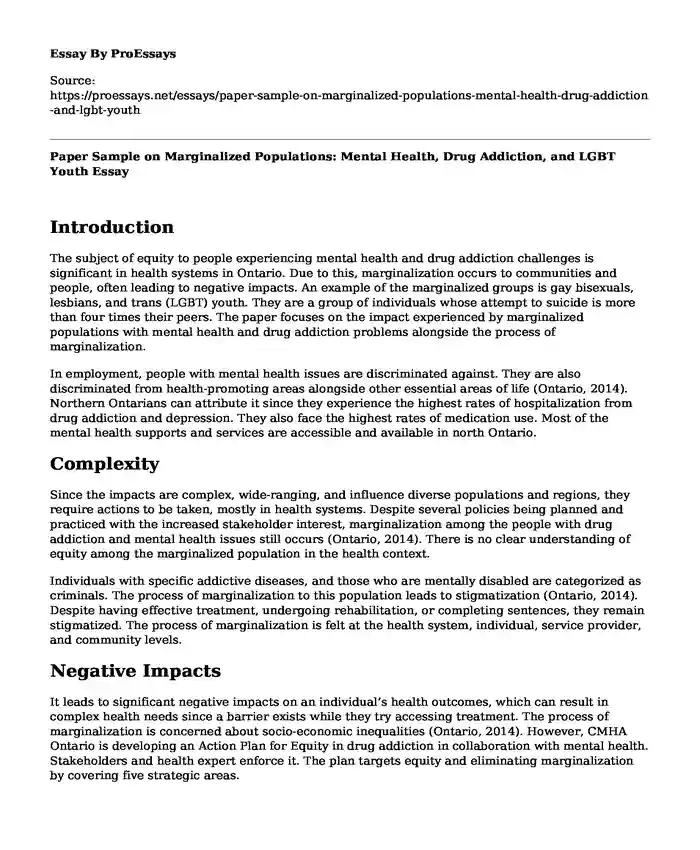Introduction
The subject of equity to people experiencing mental health and drug addiction challenges is significant in health systems in Ontario. Due to this, marginalization occurs to communities and people, often leading to negative impacts. An example of the marginalized groups is gay bisexuals, lesbians, and trans (LGBT) youth. They are a group of individuals whose attempt to suicide is more than four times their peers. The paper focuses on the impact experienced by marginalized populations with mental health and drug addiction problems alongside the process of marginalization.
In employment, people with mental health issues are discriminated against. They are also discriminated from health-promoting areas alongside other essential areas of life (Ontario, 2014). Northern Ontarians can attribute it since they experience the highest rates of hospitalization from drug addiction and depression. They also face the highest rates of medication use. Most of the mental health supports and services are accessible and available in north Ontario.
Complexity
Since the impacts are complex, wide-ranging, and influence diverse populations and regions, they require actions to be taken, mostly in health systems. Despite several policies being planned and practiced with the increased stakeholder interest, marginalization among the people with drug addiction and mental health issues still occurs (Ontario, 2014). There is no clear understanding of equity among the marginalized population in the health context.
Individuals with specific addictive diseases, and those who are mentally disabled are categorized as criminals. The process of marginalization to this population leads to stigmatization (Ontario, 2014). Despite having effective treatment, undergoing rehabilitation, or completing sentences, they remain stigmatized. The process of marginalization is felt at the health system, individual, service provider, and community levels.
Negative Impacts
It leads to significant negative impacts on an individual’s health outcomes, which can result in complex health needs since a barrier exists while they try accessing treatment. The process of marginalization is concerned about socio-economic inequalities (Ontario, 2014). However, CMHA Ontario is developing an Action Plan for Equity in drug addiction in collaboration with mental health. Stakeholders and health expert enforce it. The plan targets equity and eliminating marginalization by covering five strategic areas.
The policies that are planned for making delivery services on PWLE decisions should have embed equity. All policies for mental health at the provincial level should be planned while considering the impacts on marginalized populations. The evidence base in mental health concerned with equity issues should be expanded through new knowledge creation, collecting socio-demographic information, and knowledge exchange.
Also, collaborations between PWLE and the other marginalized populations should be fostered at levels where services are delivered. The other key strategic area is building healthy communities through spreading knowledge on the impacts of setting social determinants in the health sector. Finally, stigma and discrimination should be challenged by embracing human rights.
Conclusion
Many articles deal with statistics portraying the impacts on individuals with drug addiction and mental health issues in Ontario. Eventually, 27.9% of high school students wish to confess their mental health issues; however, they do not anyone to turn to. 28.4% of students experience psychological distress (Ontario, 2014). 14% of individuals having mental health issues have had suicidal thoughts, and 3.7% of them have attempted suicide. 5.5% of North Ontarians take anxiety and depression medication (Ontario, 2014). Due to marginalization, 70% of adults experience mental health issues that developed during the adolescence stage. 85% of individuals in Ontario started doing drugs at the age of 18 (Ontario, 2014). Since only one of five youths receives help due to mental health and addiction issues, the health systems dealing with the subject should be reviewed.
References
Ontario, C. M. H. A. (2014). Advancing Equity in Ontario: Understanding Key Concepts.[PDF]. Retrieved July 24, 2018, from http//ontario.cmha.ca/wpcontent/files/2014/05/Advancing-Equity-In-Mental-Health-Final1.pdf.
Cite this page
Paper Sample on Marginalized Populations: Mental Health, Drug Addiction, and LGBT Youth. (2023, Sep 25). Retrieved from https://proessays.net/essays/paper-sample-on-marginalized-populations-mental-health-drug-addiction-and-lgbt-youth
If you are the original author of this essay and no longer wish to have it published on the ProEssays website, please click below to request its removal:
- Reflective Essay on My Experience With Social Media Addiction
- Automation in Mexican Banking Sector Essay Example
- The Basis of Divorce in England and Wales - Essay Sample
- Essay Sample on Exploring the Impact of US Federal Immigration Policies on Local Governments
- Essay Sample on Overcoming Fear of Public Speaking: A Study of Predispositions
- Immigration in US: Humanitarian, Security & Economic Concerns - Essay Sample
- Paper Example on Enhancing Cross-Cultural Management: A Case Study of Hydro-Generation in Tanzania







